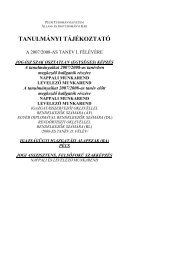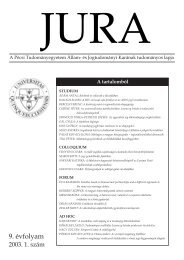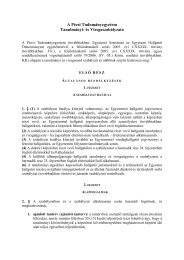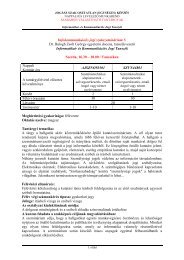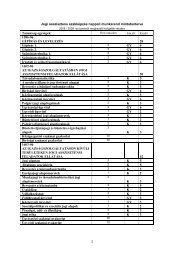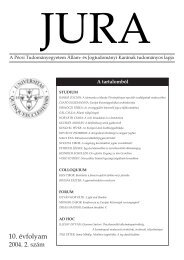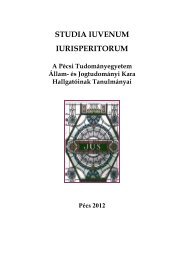2012. évi 2. szám - Jura - Pécsi Tudományegyetem
2012. évi 2. szám - Jura - Pécsi Tudományegyetem
2012. évi 2. szám - Jura - Pécsi Tudományegyetem
- TAGS
- jura
You also want an ePaper? Increase the reach of your titles
YUMPU automatically turns print PDFs into web optimized ePapers that Google loves.
Máté Julesz: Civil Society and Environmental Protection1133. Civic Control as a Post-communistPhenomenonAccording to the Act on Environmental Protection,local municipalities in Hungary are still consideredpart of civil society. De jure et de facto, local municipalitieshave comparatively little to do with civic control.Following the political changes in Eastern Europearound 1990, local municipalities were designedpartly to counterbalance the state and partly to complementthe state activity of public administrationat a local level. Local municipalities may currentlybe regarded as part of the state power. Top-downeffects implemented by the state, including localmunicipalities, can be counteracted by bottom-upeffects. The bottom-up effects are therefore left to notover-strongly positioned associations and relativelypowerless individuals.Two relatively new branches of law in theEuropean legal systems relate to environmentalprotection and consumer protection. It would be amistake to believe that countries in Eastern Europeadopted legal norms in these areas only after theera of communism. Environmental protection andnature conservation were already regulated underthe communist régime, though civic control couldnot be imagined at that time. The notion of a civilsociety organization was to be found in the text of theHungarian Act on Environmental Protection of 1976,but the state did not tolerate true civic control.Civic control appeared as a really effective systemof social functioning in the post-Soviet era. Hungary,Poland, and the new Czech and Slovak Republics sawcivic control emerge from the social, economic andpolitical changes that took place around and after thepolitical collapse within the Soviet Union. The V-4countries cooperated to achieve tangible social andpolitical changes. The ultimate aim of the changesin society and state was the creation of a marketeconomy: in Hungary, a social market economy; inRomania, a free market economy; etc.The new constellation of social and politicalfactors resulted in the opposition of state and civilsociety. Environmentalism today is directed by thestate in a top-down way, though some form ofbottom-up civic control is undergoing development.The civic control of state activity in the field of environmentalprotection can be seen as the strongestfield of civic activity in Eastern Europe. In the V-4countries, Western European civil society and civiccontrol over the state were taken as examples to befollowed. No matter how determined civic activistsmay be, however, they can attain very little if the ruleof law does not function properly.4. Environmental Axiology and CivicControlAntal Ádám writes: ’Axiology is partly ontologyand partly deontology, since axiology examines bothpresent and future.’ 1 Herbert Küpper writes: ’Thebasic rights are constitutional values which are inclose relationship with Rechtsstaat in Europe.’ 2 Therule of law functions properly when it is applied inthe service of individual environment-users and collectiveenvironmentalism. Objective environmentalvalues should be defended both by the state and civilsociety, while subjective values should be protectedin some cases by collective measures. Those subjectiveenvironmental values which are not existentialfor a community or a nation should be protected atan individual level.Water, the soil, the air, the built environment andbiodiversity are naturally objective environmentalvalues that must be protected by state and civil societyalike, but the cooperation of state and civil societycannot be restricted to objective environmentalvalues. An association may fight for permaculture,for environmental justice in connection with ethnicminorities, or for other important values, despitethese values not being completely objective.Under the auspices of the United Nations EconomicCommission for Europe, the Aarhus Conventionsignified a great step towards furnishing all citizenswith the right to have access to environmentalinformation. It is the task of the public authorities tomake such information available to the citizens, andalso to make it possible for the people to participatein decision-making concerning projects and thelegislative process. In 1998, all 15 Member States ofthe European Community signed the Aarhus Convention.The Convention is not a lex imperfecta. Onthe contrary, access to justice ensures its characteras a lex perfecta. The Aarhus Convention presents apositive image, though a constantly changing image.Assuring citizens that they have access to justice isin line with the rule of law only in the event of theseparation of the legislative, executive and judiciarypowers. A judicial review of the decisions of publicauthorities, these latter being part of the executivepower, can be expected to be fully independent fromthe public authorities.Environmental information relates partly to objectiveand partly to subjective values. Subparagraph(a) of Paragraph (3) of Article 2 of the Aarhus Conventioncovers the right of access to environmentalinformation concerning the state of elements of theenvironment, such as the air and the atmosphere, water,the soil, the land, the landscape and natural sites,JURA 2012/<strong>2.</strong>



